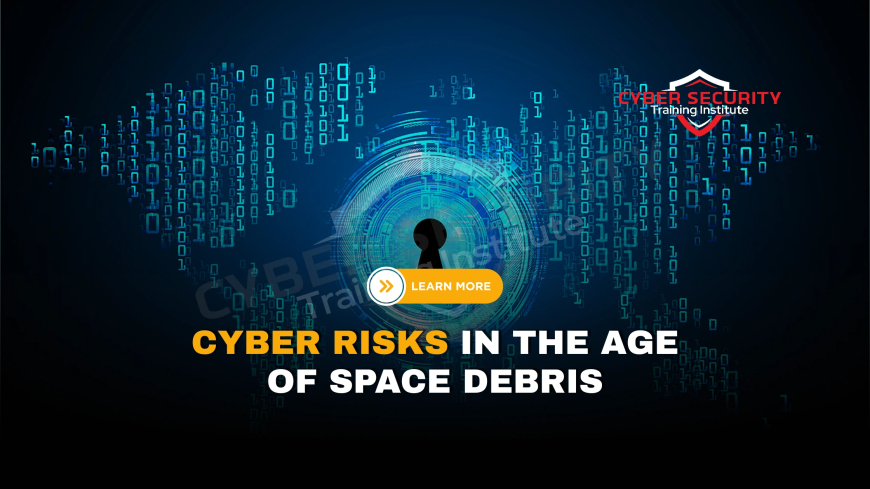How Space Debris and Cyber Threats Are Connected
Space, once a realm of wonder and exploration, is now a bustling hub of satellites, spacecraft, and, unfortunately, debris. Alongside this physical clutter, a less visible but equally dangerous threat looms: cyberattacks targeting space infrastructure. At first glance, space debris and cyber threats might seem unrelated—one is a physical problem, the other digital. However, as our reliance on space-based technologies grows, these two issues are increasingly intertwined, posing risks to global communication, navigation, and security. This blog explores how space debris and cyber threats are connected, why they matter, and what can be done to address them.

Table of Contents
- Understanding Space Debris
- Cyber Threats to Space Infrastructure
- The Connection Between Space Debris and Cyber Threats
- Real-World Implications
- Mitigation Strategies
- Conclusion
- Frequently Asked Questions
Understanding Space Debris
Space debris, often called "space junk," refers to defunct human-made objects orbiting Earth. These include old satellites, spent rocket stages, fragments from collisions, and even tiny flecks of paint. According to NASA, there are over 27,000 pieces of debris larger than 10 centimeters being tracked, with millions of smaller fragments too tiny to monitor. This debris travels at speeds up to 17,500 miles per hour, making even small pieces dangerous.
The problem is growing. Every satellite launch, collision, or explosion adds to the clutter. For example, in 2009, a defunct Russian satellite collided with an active communications satellite, creating thousands of new debris pieces. This incident, known as the Iridium-Cosmos collision, highlighted the risks of an increasingly crowded orbit.
Space debris threatens active satellites, which provide critical services like GPS, weather forecasting, and internet connectivity. A single collision can trigger a cascade effect, known as the Kessler Syndrome, where debris creates more debris, rendering entire orbits unusable.
Cyber Threats to Space Infrastructure
While space debris is a physical threat, cyber threats target the digital backbone of space operations. Satellites, ground stations, and communication networks rely on complex software and data links. These systems are vulnerable to cyberattacks, such as hacking, data interception, or signal jamming.
Cyberattacks on space infrastructure can take many forms:
- Hacking satellite controls: Attackers could take over a satellite’s navigation or communication systems.
- Signal jamming: Disrupting the radio signals between satellites and ground stations.
- Data manipulation: Altering or stealing data, such as GPS coordinates or weather information.
- Ransomware: Locking critical systems and demanding payment to restore access.
In 1998, hackers briefly gained control of a U.S.-German satellite, demonstrating early vulnerabilities. More recently, cyberattacks during geopolitical conflicts have targeted satellite networks, disrupting communication and navigation services.
The Connection Between Space Debris and Cyber Threats
Space debris and cyber threats may seem distinct, but they are connected through our dependence on satellites and the cascading effects of disruptions. Here’s how they intersect:
| Aspect | Space Debris Impact | Cyber Threat Impact |
|---|---|---|
| Satellite Operations | Debris collisions can damage or destroy satellites, disrupting services. | Cyberattacks can disable satellite functions or corrupt data, halting operations. |
| Collision Avoidance | Debris tracking relies on ground-based systems and satellite sensors. | Cyberattacks can disrupt tracking systems, increasing collision risks. |
| Data Integrity | Debris can damage sensors, leading to inaccurate data. | Hackers can manipulate data, causing misinformed decisions. |
| Global Impact | Loss of satellites affects global communication and navigation. | Cyber disruptions can disable critical services worldwide. |
The key connection lies in vulnerability. A cyberattack could disable a satellite’s ability to detect or avoid debris, increasing the risk of collisions. Conversely, debris-related damage could weaken a satellite’s cybersecurity, making it easier for hackers to exploit. Both threats amplify each other, creating a feedback loop of risk.
Real-World Implications
The combined threat of space debris and cyberattacks has far-reaching consequences. Consider these scenarios:
- Navigation Disruptions: GPS satellites are critical for everything from smartphone apps to aviation. A debris collision or cyberattack could disrupt GPS signals, causing chaos in transportation and logistics.
- Communication Breakdowns: Satellites enable global internet and phone services. Losing these due to debris or hacking could isolate communities and disrupt economies.
- National Security Risks: Military operations rely on satellites for surveillance and communication. A combined debris-cyber incident could compromise defense systems.
- Scientific Losses: Research satellites, like those studying climate change, could be rendered useless, delaying critical discoveries.
In 2022, a suspected cyberattack disrupted satellite internet services in Europe, affecting thousands of users. If such an attack coincided with a debris collision, the impact could be catastrophic, highlighting the need for integrated solutions.
Mitigation Strategies
Addressing space debris and cyber threats requires a multi-faceted approach. Here are some strategies:
- Debris Removal Technologies: Companies are developing methods like robotic arms, nets, and lasers to capture or deorbit debris. For example, the European Space Agency’s ClearSpace-1 mission aims to remove a piece of debris by 2026.
- Improved Satellite Design: Satellites can be built with end-of-life deorbiting systems to reduce debris. Hardening them against cyberattacks with encryption and secure software is also critical.
- International Cooperation: Space is a global commons. Countries must collaborate on debris tracking and cybersecurity standards. Organizations like the United Nations Office for Outer Space Affairs are working on guidelines.
- Cybersecurity Enhancements: Regular software updates, multi-factor authentication, and anomaly detection systems can protect satellites from hacking.
- Public Awareness: Educating stakeholders about the risks of debris and cyberattacks can drive investment in solutions.
Combining physical and digital protections is essential. For instance, ensuring satellites have robust debris-tracking systems while securing their software against hacking creates a dual layer of defense.
Conclusion
Space debris and cyber threats are two sides of the same coin: risks to our space-based infrastructure. As we rely more on satellites for communication, navigation, and science, these threats become more significant. Space debris endangers physical assets, while cyberattacks target the digital systems that keep them running. Together, they create a complex challenge that requires innovative technologies, international cooperation, and proactive policies. By addressing both issues holistically, we can protect our orbital environment and ensure the benefits of space exploration for future generations.
Frequently Asked Questions
What is space debris?
Space debris refers to human-made objects in orbit, like old satellites, rocket parts, and fragments, that no longer serve a purpose but can collide with active spacecraft.
How does space debris form?
Debris forms from satellite launches, collisions, explosions, or natural wear, like paint chipping off spacecraft.
Why is space debris dangerous?
It travels at high speeds and can damage or destroy satellites, disrupting services like GPS and communication.
What is the Kessler Syndrome?
Kessler Syndrome is a scenario where debris collisions create more debris, leading to a cascade that makes orbits unusable.
How common are space debris collisions?
Major collisions are rare but significant, like the 2009 Iridium-Cosmos crash, which created thousands of debris pieces.
What are cyber threats to space systems?
They include hacking satellite controls, jamming signals, manipulating data, or locking systems with ransomware.
How do cyberattacks affect satellites?
They can disable satellite functions, corrupt data, or disrupt communication with ground stations.
Can cyberattacks cause space debris?
Indirectly, yes. A cyberattack could prevent a satellite from avoiding debris, increasing collision risks.
How are space debris and cyber threats connected?
Both threaten satellite functionality, and a cyberattack could impair debris avoidance systems, amplifying risks.
What happens if a satellite is hit by debris?
It could be damaged or destroyed, disrupting its services and potentially creating more debris.
Can hackers take over a satellite?
Yes, if vulnerabilities exist, hackers could control a satellite’s navigation or communication systems.
How do satellites avoid debris?
They use tracking data from ground stations and onboard sensors to maneuver away from potential collisions.
Are there laws governing space debris?
International guidelines exist, like those from the UN, but enforcement is limited, relying on voluntary compliance.
How can we reduce space debris?
Methods include deorbiting old satellites, using robotic systems to capture debris, and designing satellites to minimize debris creation.
What role does cybersecurity play in space?
It protects satellites and ground stations from hacking, ensuring reliable operation and data integrity.
Who is responsible for space debris?
Countries and companies launching satellites are responsible, but global cooperation is needed for solutions.
Can space debris affect life on Earth?
Most debris burns up on reentry, but large pieces could reach the surface, though this is rare.
How do cyberattacks impact global services?
They can disrupt GPS, internet, and communication services, affecting industries like transportation and finance.
What is being done about cyber threats in space?
Space agencies and companies are implementing encryption, regular updates, and anomaly detection systems.
Why is international cooperation important?
Space is a shared resource, and coordinated efforts are needed to track debris, set standards, and enhance cybersecurity.
What's Your Reaction?
 Like
0
Like
0
 Dislike
0
Dislike
0
 Love
0
Love
0
 Funny
0
Funny
0
 Angry
0
Angry
0
 Sad
0
Sad
0
 Wow
0
Wow
0









![How to Install RHEL 10 on VMware/VirtualBox [Tutorial]](https://www.cybersecurityinstitute.in/blog/uploads/images/202509/image_430x256_68b56dc967a4a.jpg)





